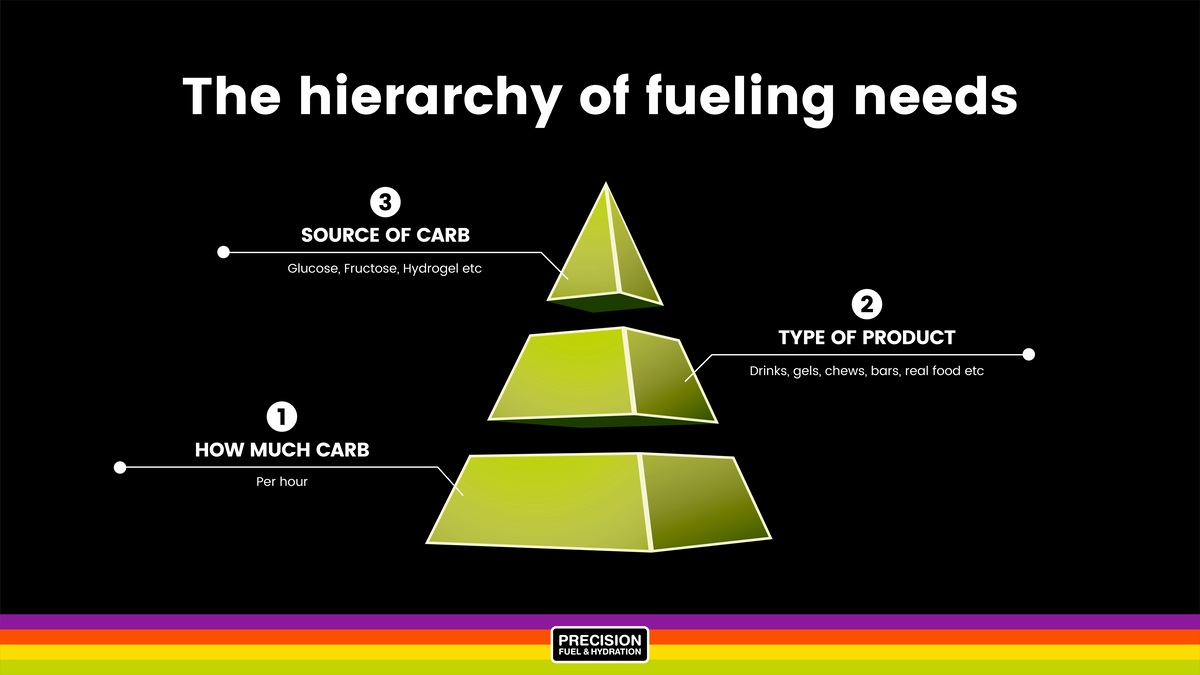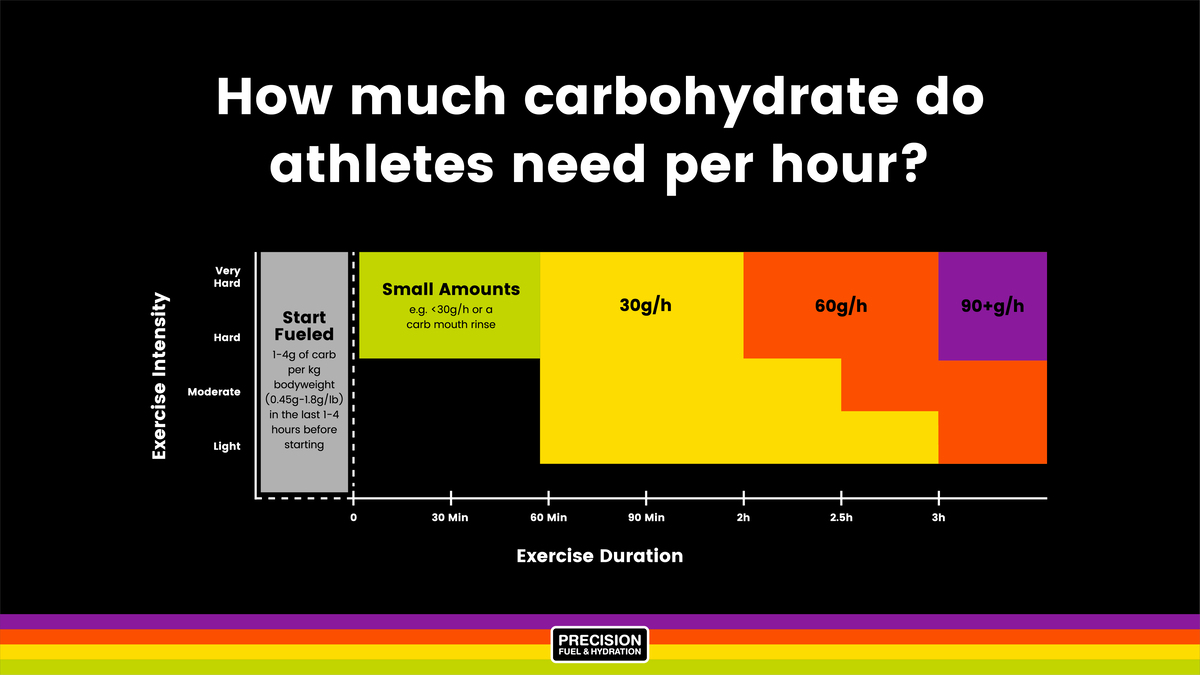When it comes to powering high intensity endurance exercise, carbohydrate is the main source of fuel used by your body.
But how much carb do you need to consume to perform at your best?
This is the fundamental question to answer when working out your fueling strategy for races and key training sessions. Despite this being so critical, it’s surprising how many athletes lack a clear picture of what their carb intake should be…
Getting your priorities straight
The confusion around how much carbohydrate athletes need to optimally fuel their performance is partly (and unintentionally) created by the last few decades of sports nutrition marketing activity, which has muddled up our priorities and got us putting the proverbial cart before the horse.
You see, most brands tend to focus on the source of carbohydrate in their products rather than how much you should be taking in, or whether the type of product (a gel or drink say) suits your individual needs. There’s a near constant hype cycle around the latest and greatest new formulation or source of carb. Think ‘Hydrogel Technology’, ‘Cluster Dextrin™’ or ‘SuperStarch’, to name just three.
This isn’t because this is the most important factor when it comes to fueling, but because it offers a concrete way for otherwise very similar products to be differentiated from one another in an extremely crowded marketplace.
There’s much less discussion about how to figure out how many grams of the stuff you actually need to be putting in your mouth to perform at your best, despite this being a more important subject. The most we usually get is generic usage advice like “Take one to three servings per hour during exercise, less if you're also using a sports drink.”
Considering ‘Maslow’s Hierarchy of Needs’ is helpful here. In Maslow’s famous pyramid model, our most fundamental needs as humans (such as food, water and warmth) are positioned at the base. The theory is that only once these basic needs are met, we can benefit from moving up to worrying about other needs like safety, belongingness, love, self-esteem and self-actualisation respectively.
We can think of fueling in the same way...

This doesn’t mean that the source of carbs in energy products is totally irrelevant, it’s just not as important as getting the right amount of calories in and delivering them in a format that works from a logistical point of view in your specific sporting situation.
So, read on if you want to know what the science - and a bit of hard-won practical experience - has to tell us about different levels of carb intake for optimal performance...
Why do we need carbs during longer, more intense exercise?
It’s glycogen that provides much of the carbohydrate needed to fuel your body during the early part of a bout of exercise. Glycogen is formed of chains of thousands of glucose molecules and most of it is stored in your muscles and liver. Think of it like your current/checking bank account for energy, with fat being more like your savings for a rainy day.
Like the money in most people's day-to-day bank accounts, glycogen is very much a finite resource. 90-120 minutes of hard activity will generally deplete your stores enough to significantly compromise your performance.
So, at some point, taking in carbs (usually in the form of drinks, energy gels, bars or other carb-rich foods) is either helpful or absolutely necessary to maintain a high level of output for a long period of time. That’s because relying on fat to fuel exercise does not allow for the levels of output associated with racing hard and fast.
Carbohydrate ingested during exercise is known as ‘exogenous’ fuel. It’s extra ‘cash in your hand’ whilst you’re out spending (exercising) hard and fast.
Because of the performance-enhancing potential it holds, the exact amount and type of exogenous fuel to consume has been the subject of much research and trial and error over the last 50 years or so.
This is handy for the modern athlete because, once you cut through the hype and distraction that exists in most of the sports nutrition market, there are some pretty clear, tried and tested guidelines on how much carb you need to consume in order to optimise your performance over various durations and intensities of exercise.
How much carbohydrate do you need per hour?
At this point, it’s worth stressing a couple of important assumptions that have been made when pulling together the carb intake recommendations that follow.
- The first is that you’ll be starting exercise with robust glycogen stores. This means having had a light but carb-dense meal or snack 2-3 hours before the workout or race in question. If that’s not the case, then your carbohydrate requirements during exercise may well be higher than suggested (if tolerable), as your internal ‘fuel tanks’ could already be somewhat depleted before the start.
- The second is that the recommendations here are based on the concept of optimising performance. Optimising performance is not the same as ‘just getting round’. It implies that you are pushing yourself very hard for the given duration - as most people would try to do in a competitive setting.
In other words, the same rules don’t apply to fueling an easy 2-hour training ride or run at a steady pace. At lower intensities, much more fat can be utilised than when you’re on the rev limiter, hence the requirement for exogenous carbs tends to be significantly reduced when you’re not working as hard.
Having got those assumptions straight, we can now look at the basic recommendations...
A visual guide to how much carbohydrate to take in per hour

*When ingesting more than 60 grams of carbohydrate per hour there can be advantages to using a 2:1 glucose/fructose mixture
During exercise lasting less than 1 hour
In almost all cases, athletes who are starting well-fueled needn’t worry about ingesting carbohydrates during activities lasting less than an hour.
Your glycogen stores have got you covered for this and they typically just benefit from being topped up with a sufficiently carb-rich recovery meal or snack afterwards to promote rapid recovery; especially if you intend to train or compete again within a short time window. With that said, there’s some nuance to consider depending exactly how long you’re exercising for and at what intensity.
For sure, when exercise is extremely short in duration (<30 minutes) carbohydrate ingestion has been shown to have little-to-no effect on performance outcomes.
But when exercise is of slightly longer duration (45-60 minutes) and of an “all-out” intensity then there is some evidence that performance may benefit from a small amount of carbohydrate ingestion or a carb mouth rinse, which might be more convenient during intensive racing when swallowing is hard.
This makes something like a carbohydrate-rich drink the best choice for such hard and fast efforts, in part because it’s easier to consume (or to ‘swish and spit’) than a gel, energy bar or slice of pizza.
During exercise lasting 1-2 hours
As duration increases, so too do the potential benefits of exogenous fueling. In this time frame, carbohydrate ingestion will almost certainly significantly improve your performance.
For bouts lasting between 1-2 hours, it can be beneficial to consume ~30-60 grams of simple carbs per hour. This equates to about 500ml-1l (16-32oz) of a ‘standard’ isotonic (~6% carb) energy drink, or about 1-2 standard energy gels per hour.
The harder the work and longer the duration within this bracket, the more appropriate it is to push the intake up towards ~60 grams per hour. This is especially true for athletes who are super fit and therefore able to sustain extremely high level workloads.
Certainly beyond two hours, research generally points towards a solid dose-response relationship with higher carb intakes usually eliciting better performance outcomes.
During exercise lasting more than 2 hours
Athletes significantly passing the 2-hour mark can benefit from higher intakes of 60 to 90 grams of carbohydrate per hour, as long as the amount consumed doesn’t cause stomach problems. As a result, it’s common to see faster competitors in long races tend to have the highest carbohydrate intake rates too.
We’re routinely impressed with the high levels of carb intake reported hour after hour by the Tour De France riders and IRONMAN winners we work with. It highlights the fact that racing long distances at a fast pace is as much an eating event as it is an athletic one!
The higher the amount of carbohydrate you’re aiming to ingest, the more crucial practicing this and ‘training your gut’ becomes.
An hourly intake of ~90 grams per hour (ie. 3 x PF 30 Gels or 3 x PF 30 Energy Chews or 1 x PF 90 Gel) is not something all athletes can achieve immediately and it can take a bit of time to build up to this rate of consumption, especially if you’ve been prone to suffering from GI issues in the past.
Significantly, this rate of carb consumption is where there may be some benefit in paying attention to the highest level of our Hierarchy of Fueling Needs pyramid - i.e. the source of carbohydrate ingested. This is where ‘multiple transportable carbohydrates’ (MTCs) such as Glucose/Fructose blends can often be preferred in order to help to maximise absorption of very high amounts of carb via your gut. MTCs are a fancy way of saying different sources of sugar.
At this point, it’s worth acknowledging that ~90g/hr was considered something of a firm ceiling for carb intake until relatively recently, when more and more anecdotal reports from the field started suggesting some athletes were routinely consuming even more than that. For most of us, even approaching 90g/hr is an impressive amount of fuel to be able to absorb, but there’s definitely a movement in elite sport for athletes to use even higher doses.
Also, when exercise goes ‘ultra’ (often defined as 6 hours plus in duration) there are other considerations that come into play with fueling beyond a simple ‘carbs per hour’ rationale. These include the benefits of taking in some fat and protein via ‘real foods’, as well as problems associated with taste fatigue if too much of one single fuel source is used. A full discussion of all the ins and outs of fueling for ultras is beyond the scope of this article but it’s an interesting topic explored in more detail here.
All that being said, the key thing to take away from this section is the basic 30 to 60 to 90g per hour concept and how the dose of carbs tends to benefit from being significantly dialled upwards as exercise duration increases.
In our experience, most amateur athletes tend to not consume enough carbohydrate per hour during hard training sessions and races. So, don’t be surprised if the numbers we’ve been talking about seem a little high compared to what you’re used to doing. If this is the case, it’s actually great news as it means there’s a strong chance you’ll be able to unlock some improvements in your performance and recovery if you’re able to dial your intake up and give your body a little more fuel to burn when you’re working hard.
Training your gut to absorb levels of intake above ~60g per hour may well be a necessary step if you’re looking to really optimise your performance in very long, hard events, but don’t be put off if you initially experience some level of GI distress with high levels of intake.
This is an area where the research is currently playing catch-up with what elite athletes appear to have been doing for some time, and so it probably represents the next area in which our collective understanding will continue to improve.
In the meantime, if you’re seeking to increase your carb intake, gradually tweaking your consumption upwards from whatever your current tolerable limit is during one or two hard sessions per week over a period of 4-6 weeks seems to be the recommended approach to training your gut from those who have tried it successfully in the field.
Know Your Numbers
The Fuel & Hydration Planner is designed to help athletes know their numbers. You can use the calculator to work out how much carbohydrate you're likely to need per hour for the intensity and duration of your chosen activity.
Our PF 30 Gel, PF 90 Gel, PF 300 Flow Gel, PF 30 Chews and both the Carb & Electrolyte Drink Mix and the Carb Only Drink Mix say exactly how much carb is in each serving on the front of the packet to make it easier for you to then hit your numbers during exercise.
Should body size influence carbohydrate intake?
It’s easy to see why you’d think that it would be; surely athletes of greater body mass require a greater carbohydrate dose to fuel the higher energy outputs they need, right?
But all of the recommended carbohydrate intakes during exercise we’ve discussed so far are expressed in simple grams per hour, not grams per kilogram of bodyweight per hour.
The reason for this is that body mass isn’t actually a hugely relevant factor because the amount of carbohydrate our muscles can use is primarily dictated by the rate at which sugars can be absorbed through our gastrointestinal tract and all athletes seem to absorb carbohydrate at pretty similar rates, regardless of body size.
As such, the ballpark advice is essentially the same for a 50kg (110lbs) athlete as it is for a 90kg (198lbs) athlete because, for both, the limiting factor in the process is how much carbohydrate they can move through the gut into their bloodstream per minute - and that is very similar no matter their total body size.
Keeping this in mind, evidence suggests that those with a lower body mass can benefit more from relatively high carbohydrate doses than their bigger counterparts. This is because the relative contribution of exogenous carbohydrate oxidation to total energy expenditure is greater for athletes with lower body mass.
It’s worth noting that many studies in this area have tended to use athletes with somewhat limited ranges of body sizes. So, at the absolute extremes there may be some differences in carbohydrate absorption rates when comparing the very biggest with the very smallest athletes.
There's also a natural level of variation from any athlete to another in terms of what can be absorbed just because no two humans and their gut microbiomes are identical. But, overall, it appears fair to say that body size is much less of an influential factor in setting carb intake rates than common sense would otherwise suggest.

What does 30, 60, 90g of carb per hour really look like?
How an athlete chooses to ingest their carbs is a very individual matter and there are many options to choose from - from specific sports fuels like gels, chews, bars, Energy Drink Mix to all sorts of real foods.
The pros and cons of each warrant a discussion of their own, but suffice to say that as long as whatever you take ‘agrees’ with your digestive system and works in a practical sense given the logistical constraints of your sport, there are few ‘right' or 'wrong’ answers.
The key factor, as we’ve continued to stress throughout this whole article, is delivering roughly the right amount of carbohydrate per hour in order to adequately address your energy needs.
Here’s a table with the typical carb content you’d expect to find in a number of common energy products:
| Food / sports nutrition product | Carbohydrate content |
|---|---|
| Sports energy gel* | Usually 20-30g (variable) |
| PF 30 Gel | 30g |
| PF 90 Gel | 90g |
| PF 60 Energy Drink Mix | 60g per litre |
| PF 30 Chews | 30g (2 x 15g chews) |
| Sports chews* (per serving, can be ~4 chews) | 20-30g (variable) |
| Typical energy bar | 40-60g |
| Medium banana | ~25g |
| Jelly babies (per 4 sweets) | 21g |
| Coca Cola (375ml can) | 40g |
*Always check the packaging on products as different brands contain different types and amounts of carbohydrates.
Ok I know my numbers now, so what’s next?
Now that you’ve hopefully got a better idea of the amount of carbohydrate you need to be taking in to perform at your best, it’s worth considering what types of products or foods will be best for you.
It’s perhaps a fairly obvious statement to make but this can differ widely from sport to sport and is also heavily dependent on the duration and intensity of your exercise, the environment you’re competing in, and of course your personal taste preferences.
